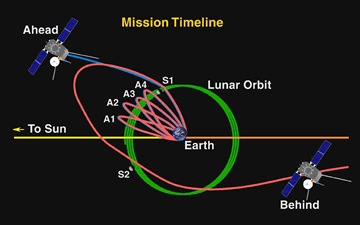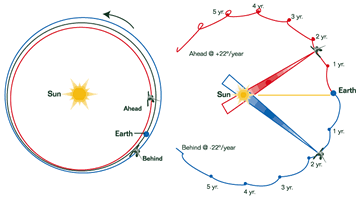|
|
Mission overview:
The Solar Terrestrial Relations Observatory (STEREO) Mission is comprised
of two nearly identical spacecraft with identical scientific payloads. The
science instruments provide both remote images and in situ particle
and magnetic field observations. During its two-year mission, STEREO will
explore the origin and evolution of coronal mass ejections.
During the first three months after launch, the spacecraft were in "phasing" orbits
around the Earth-Moon System. STEREO-A underwent a single gravity assist from
one lunar swing-by (S1), while STEREO B required two lunar swing-bys (S1, S2)
to achieve the necessary energy to attain their final heliocentric orbits.
The spacecraft and instruments were commissioned during these first three months.
Science operations commenced at the end of January 2007. |
 |
Having attained their heliocentric (Sun-centered) orbits,
the two observatories are gradually drifting away from each other at a rate of 45 degrees
per year. The Ahead spacecraft orbits slightly closer to the Sun, with a spacecraft “year” of
346 days (Earth days). The Behind spacecraft is slightly further out from
the Sun, with an orbital period of 388 days.
This orbital separation allows the remote imager experiments to obtain 3-D
images of the Sun, while the particle and field experiments sample the solar
material from different solar longitudes as it flows by the spacecraft. |
 |
Current
location of STEREO relative to the Sun and Earth is available from the SSC.
Mission operations:
The ground system facilities that provide special support for the STEREO mission
include:
The DEEP
SPACE NETWORK (DSN) ground stations provide space-to-ground services for
transmitting commands and telemetry/tracking data, as well as signal processing
and science data handling during the mission.
The MISSION
OPERATIONS CENTER (MOC), located at JHU/APL, serves as the focal point for
the STEREO on-orbit operations control. It provides the hardware and the software
necessary for the successful conduct of operations activities.
The STEREO
SCIENCE CENTER (SSC) managed by NASA GSFC serves as the central facility
responsible for telemetry distribution, archiving, and other central functions,
such as long-term science planning and coordination with the science teams. The
SSC is also responsible for the processing of the real-time Space Weather data.
The SSC is the principal Mission interface with the scientific community and
the public at large. Planned
Activities Schedule is maintained by the SSC.
The PAYLOAD OPERATIONS CENTER (POC) facilities, located at
NRL, UMN, UCB, CalTech, and UNH, are responsible for STEREO instrument operations,
assessment, and data operations. The PLASTIC Operations Center is located
at UNH.
|
 |